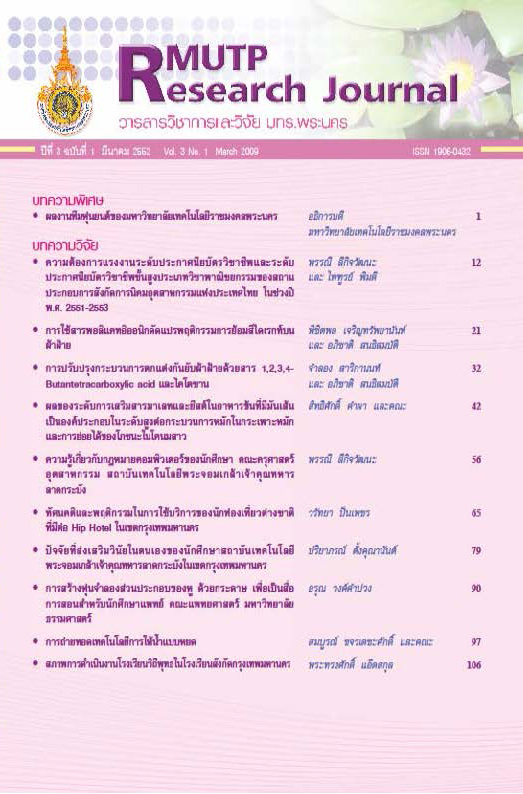การใช้สารพอลิแคทอิออนิกดัดแปรพฤติกรรมการย้อมสีไดเรกท์บนผ้าฝ้าย
Main Article Content
Abstract
บทคัดย่อ
ปัจจุบันการย้อมผ้าฝ้ายด้วยสีไดเรกท์แบบจุ่มแช่ ต้องใช้อิเล็กโตรไลท์ (เกลือ) จำนวนมากเพื่อลดประจุ บนผิวของเส้นใย นอกจากนี้อิเล็กโตรไลท์ปริมาณสูง (40-100 กรัม/ลิตร) ที่ใช้ในการย้อม อาจส่งผลต่อปัญหา สิ่งแวดล้อม และต้นทุนในการบำบัดนํ้ามากขึ้น จึงเกิดแนวคิดศึกษาการใช้สารพอลิแคทอิออนิกดัดแปรพฤติกรรม การย้อมสิไดเรกท์บนผ้าฝ้าย เพื่อเพิ่มสมบัติการดูดซึมและความคงทนของสี เมื่อเปรียบเทียบระหว่างผ้าฝ้าย ที่ผ่านการตกแต่งและผ้าฝ้ายที่ไม่ได้ผ่านการตกแต่ง พบว่ามีความเป็นไปได้ว่า สารพอลิแคทอิออนิกทำให้เกิด รูปแบบการย้อมที่แตกต่างออกไป กล่าวคือ สีย้อมจะผนึกติดบนเส้นใยด้วยแรงทางประจุ ทำให้ผ้าที่ผ่านการ ตกแต่งด้วยสารพอลิแคทอิออนิกมีการดูดซึมและความเข้มสีดีกว่าผ้าที่ไม่ได้ผ่านการตกแต่ง แม้ว่าจะทำการย้อม โดยปราศจากสารอิเล็กโตรไลท์และยังมีสมบัติความคงทนของสิดีขึ้น งานวิจัยนี้มีวัตถุประสงค์เพื่อคึกษาว่าการตกแต่งผ้าฝ้ายด้วยสารพอลิแคทอิออนิก ช่วยเพิ่มความสามารถในการย้อมสีไดเรกท์ภายใต้สภาวะที่เหมาะสม เช่น การสร้างประจุบวกบนเล้นใย ซื่งสามารถย้อมได้โดยไม่ต้องทิ้งนํ้าจากการตกแต่งและไม่จำเป็นต้องใช้ อิเล็กโตรไลท์ ทำให้เกิดความประหยัด
คำสำคัญ : สารพอลิแคทอิออนิก; พฤติกรรมการย้อม
Abstract
In the current practice, cotton fabric is predominantly dyed with direct dyes in the presence of a considerable amount of electrolyte (Salt) to reduce negative charge on fiber surface. Thus, the high concentration (40-100 g/1) of electrolyte required in cotton fabric dyeing may pose additional effluent problem and waste water treatment costs. The use of polycationic agent to modify the dyeing behaviour of direct dyes on cotton fabric is investigated. Normally, polycationic agent had been treated on dyed fabric to improve fastness properties. The comparison of untreated and pretreated cotton fabric was found that the polycationic agent offers the potential for different dyeing patterning possibilities. The dyes was fixed on the fiber by ionic force. So, color strength and exhaustion of pretreated fabric was better than untreated fabric and increased in fastness properties, even when dyeing had been carried out in the absence of electrolyte. The purpose of the present work was to determine whether the pretreatment of cotton fabric with polycationic agent could enhance the dyeability of the fiber with direct dyes under appropriate condition such as assuming a positive charge on fiber which permitted “electrolyte-free” dyeing after modification without drain and helped reduce dyeing cost.
Keywords : Polycationic Agent; Dyeing Behaviour


